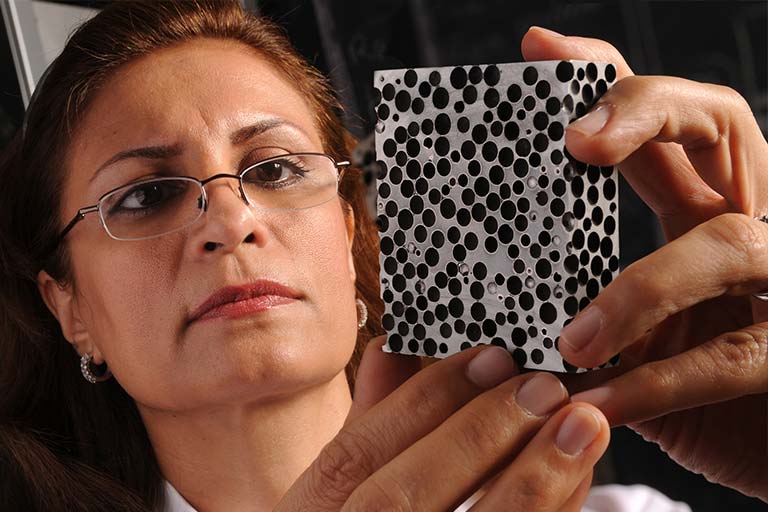Composite metal foam developers are producing lightweight steel structures so strong they can turn bullets to dust-like shards on impact
Few people are likely to think of foam as a resilient protective material, but a new kind of steel foam enabling the creation of super-lightweight body and vehicle armour might just change that.
Steel composite metal foams (CMFs) are one of the most exciting new developments in composite materials. By combining steel in two different forms, its strength and resistance properties can be greatly enhanced.
A unique structure
CMFs have a unique spongy structure, and are manufactured using a random arrangement of hollow steel spheres suspended in a fine particulate steel powder.
This is then heat treated in a process called sintering. Here, high temperatures and compression are applied to fuse the particulate powder with the steel ‘bubbles’, producing the steel sponge formation.
 The steel foam’s spongy structure gives it its unique qualities.
The steel foam’s spongy structure gives it its unique qualities.
Steel metal foams are valued for their distinct mechanical, thermal, electrical and acoustic characteristics. In the case of armour systems, their strength comes from a unique ability to dissipate ballistic energy through the flexible deformation relationship between the air-filled spheres and the steel matrix surrounding them.
Because of their porosity and high surface area to volume ratio, CMFs can absorb a large amount of mechanical energy when they are deformed.
Strength under fire
CMFs have been under development at North Carolina State University for more than 12 years, and have been extensively tested by the US Department of Defence for their ballistic applications.
Experiments have shown that a 2.5cm-thick test piece of CMF can outperform an identical thickness of solid steel plate in bullet resistance, but is six times lighter.
In fact, the 2.5cm CMF provides enough ballistic resistance to splinter a 7.62 x 63mm standard-issue M2 armour-piercing bullet into dust-like fragments upon impact.
A variety of uses
While CMFs have displayed huge potential in the development of new types of armour, this is not their only application. Other areas are being actively explored to take advantage of the properties of this new type of steel formation.
When tackling nuclear waste, CMFs are being considered for use in shielding against X-rays, gamma rays and neutron radiation in waste containers. This is because of their combination of high-energy absorption capability, low thermal conductivity, low co-efficient of thermal expansion and superior dimensional stability. At high temperatures, a CMF made of steel expands significantly less than bulk steel and in a more regular and predictable way.
Experiments have shown that a 2.5cm-thick test piece of CMF can outperform an identical thickness of solid steel plate in bullet resistance, but is six times lighter.
The lightness, heat resistance and mechanical properties of CMFs have also put them in the frame as structural, shielding and thermal insulation materials for a new generation of space vehicles and aircraft, and NASA is currently evaluating their potential.
CMFs have twice the resistance to heat than plain steel, primarily because heat travels more slowly through air than through metal. Recent studies into the thermal behaviour and fire retardant properties of composite metal foams show they offer good thermal insulation, superior thermal stability, and excellent flame retardant performances compared to base steel.
Steel is well established as a reliable and adaptable material for a wide range of commercial uses. But now steel-steel composite materials which merge two distinct forms into one, provide fresh potential for structural and functional applications.
Images: Advanced Materials Research Group
Video: North Carolina State University